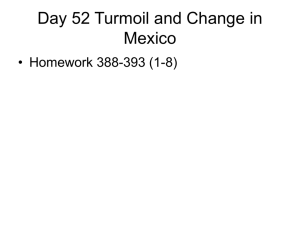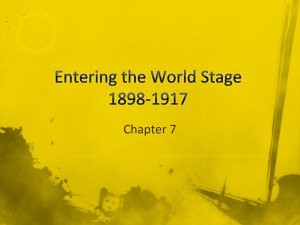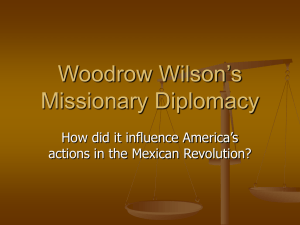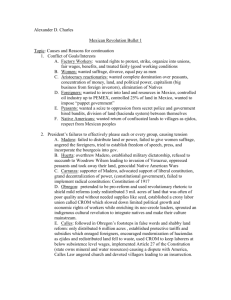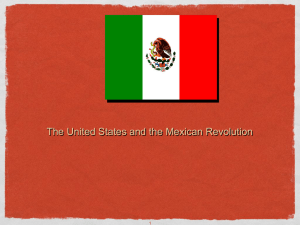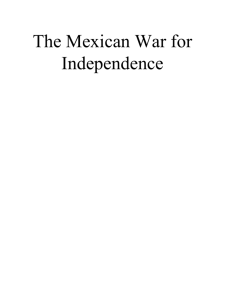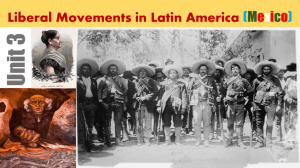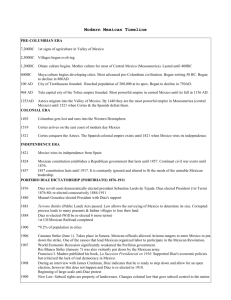Mexican Revolution Notes 2011
advertisement
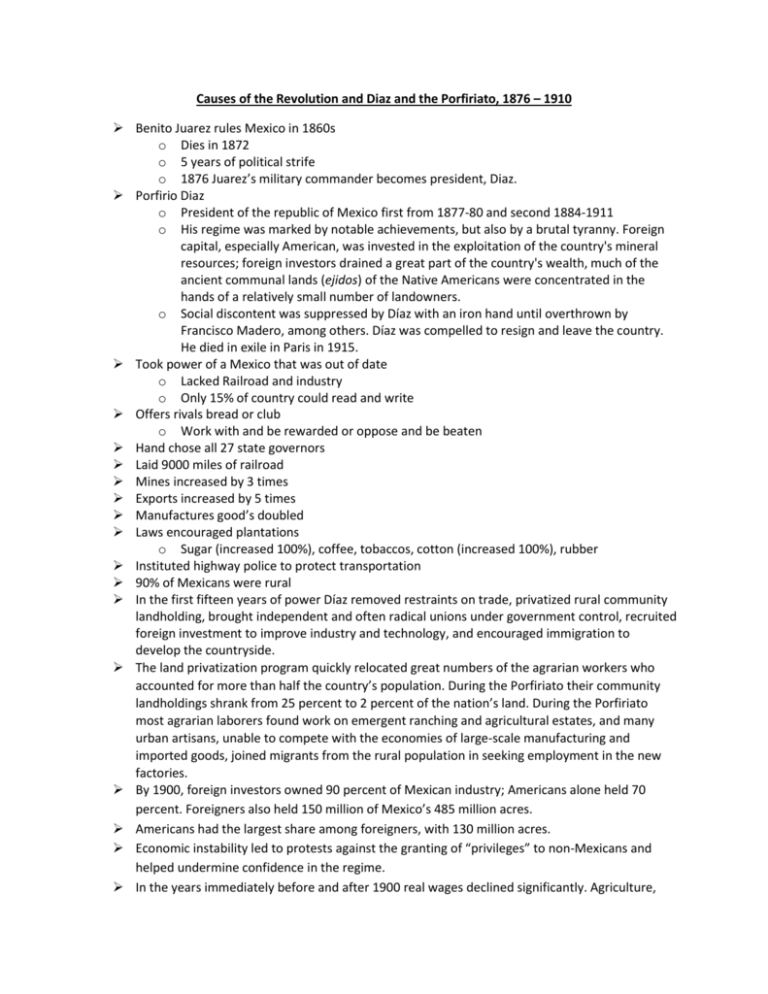
Causes of the Revolution and Diaz and the Porfiriato, 1876 – 1910 Benito Juarez rules Mexico in 1860s o Dies in 1872 o 5 years of political strife o 1876 Juarez’s military commander becomes president, Diaz. Porfirio Diaz o President of the republic of Mexico first from 1877-80 and second 1884-1911 o His regime was marked by notable achievements, but also by a brutal tyranny. Foreign capital, especially American, was invested in the exploitation of the country's mineral resources; foreign investors drained a great part of the country's wealth, much of the ancient communal lands (ejidos) of the Native Americans were concentrated in the hands of a relatively small number of landowners. o Social discontent was suppressed by Díaz with an iron hand until overthrown by Francisco Madero, among others. Díaz was compelled to resign and leave the country. He died in exile in Paris in 1915. Took power of a Mexico that was out of date o Lacked Railroad and industry o Only 15% of country could read and write Offers rivals bread or club o Work with and be rewarded or oppose and be beaten Hand chose all 27 state governors Laid 9000 miles of railroad Mines increased by 3 times Exports increased by 5 times Manufactures good’s doubled Laws encouraged plantations o Sugar (increased 100%), coffee, tobaccos, cotton (increased 100%), rubber Instituted highway police to protect transportation 90% of Mexicans were rural In the first fifteen years of power Díaz removed restraints on trade, privatized rural community landholding, brought independent and often radical unions under government control, recruited foreign investment to improve industry and technology, and encouraged immigration to develop the countryside. The land privatization program quickly relocated great numbers of the agrarian workers who accounted for more than half the country’s population. During the Porfiriato their community landholdings shrank from 25 percent to 2 percent of the nation’s land. During the Porfiriato most agrarian laborers found work on emergent ranching and agricultural estates, and many urban artisans, unable to compete with the economies of large-scale manufacturing and imported goods, joined migrants from the rural population in seeking employment in the new factories. By 1900, foreign investors owned 90 percent of Mexican industry; Americans alone held 70 percent. Foreigners also held 150 million of Mexico’s 485 million acres. Americans had the largest share among foreigners, with 130 million acres. Economic instability led to protests against the granting of “privileges” to non-Mexicans and helped undermine confidence in the regime. In the years immediately before and after 1900 real wages declined significantly. Agriculture, suffered disastrous setbacks after 1907. So did the textile industry: Between 1895 and 1910, the number of workers dropped by a third. Failures of the corn and cotton crops led to famine and food riots in several northern cities. Mining, the linchpin of attempts to modernize industry, collapsed when the bottom fell out of the world silver market. Market difficulties also struck the timber industry, forcing companies to close. Unemployed mine, timber, and ranch workers crowded the towns of the near and far north. Sugar producers and workers saw the U.S. market dry up as the result of a new American tariff designed to protect American sugar producers in Cuba and displaced workers. Reduced railroad and port activity reflected the overall decline of the mining, timber, agricultural, and ranching industries. Famine stalked dispossessed peasants and workers north and south of Mexico City. Díaz refused to commit funds for the relief of the now virtually landless rural working classes, or to help urban workers and the small businessmen who suffered incalculable losses. The economically vulnerable regional elites were becoming fed up with Díaz and were chafing at their lack of political influence. Díaz’s strategy of economic development based on dictatorial control, a continuing flow of foreign capital, foreign colonization, and ever growing export market demand had proved unrealistic in the face of growing pluralism, the rise of nationalism, a global contraction, and a market downturn in the United States, Mexico’s principal trade partner. Biggest issue was ownership o Ejidos owned by Indians and worked communally o Haciendas owned by Euro’s, rich families o Diaz believed haciendas needed to be worked efficiently o Allowed land barons to strip millions of acres from Indians Southern Indians turn to Zapata for help o Began to revolt to restore land rights Northern Indians turned to Pancho Villa 1895- 20% of Mexicans owned at least a small plot of land or part in an ejido 1910- Only 2% Many farmers robbed of land, packed the cities in hope of work o Created poor slums on outskirts of Mexico City Haciendas would work peasants o Buy food at hacienda store Indians lost farms and ended up tilling the same soil that had been owned by their families for years Diaz ignored the atrocities to push Mexico into new use of industry and agriculture efficiency End of Diaz Term o Whites from U.S. and Europe exploited Mexico economic market o Foreign investment was key to industrial revolution o Brought in white skilled labor, paid by that of locals o 90% of Mexicans filled low level jobs Diaz controlled government but foreign industries controlled the economy U.S. companies owned o Railroads o ¾ of Mines o ½ of Oil o 1/3 of total economy British: Gold and Silver Mines French: Textile Mills Spain: Tobacco and coffee Foreign investment increased prices on staples of diet Average Mexican earned less in 1910 than 1810 Cost more per day to rent a mule than a man Life before the Revolution o The average Mexican was worse off economically and politically in 1910 than he/she had been in 1810 o Industrial wages averaged 12.5 cents a day o Less than 1% of families controlled 85% of the nation’s wealth Four main causes o Dictatorship-like rule of Porfirio Diaz for over 30 years o Exploitation and poor treatment of workers (low wages, abusive conditions, and legal discrimination) o Great disparity between rich and poor (income gap) o Foreign intervention in economy and their exploitation of Mexico and its people Leaders and Major Players Francisco Madero o Madero was jailed for allegedly inciting a revolt. Madero was released in November 1910 and fled to Texas, where he proclaimed a revolution against Díaz. Madero reentered Mexico and launched a military campaign that culminated in the capture of Ciudad Juárez in May 1911. Díaz resigned, Madero became provisional president, and in November 1911, Madero was elected president of Mexico o February 1913, the commander in chief of the army, General Victoriano Huerta, overthrew Madero and assumed the presidency. On February 22, 1913, while awaiting trial on a charge of treason, Madero was killed, reputedly during an attempt to escape. Pancho Villa (Centaur of the North) o Upon the outbreak of the revolution of 1910-1911 against the Mexican dictator Porfirio Díaz, Villa offered his services to the rebel leader Francisco Madero. o During Madero's administration he served under the Mexican general Victoriano Huerta, who sentenced him to death for insubordination. Villa escaped to the United States, and following the assassination of Madero and the assumption of power by Huerta in 1913, he returned to join the opposition under the revolutionary leader Venustiano Carranza. o The two men soon became enemies, however, and when Carranza seized power in 1914, Villa led a rebellion against him. o The following year the U.S. government recognized Carranza as president of Mexico, and on March 9, 1916, Villa crossed the border and attacked Columbus, New Mexico, killing a number of citizens and destroying part of the town. o After the overthrow of Carranza in 1920, he came to terms with the new government and retired to a ranch near Hidalgo del Parral, Chihuahua. He was assassinated there in 1923. Emiliano Zapata (Attila of the South) o He recruited an army of Native Americans from villages and haciendas in Morelos and, under the rallying cry “Land and Liberty,” joined the Mexican revolutionist Francisco Madero in the 1910 revolt against the Mexican soldier-statesman Porfirio Díaz. o Having lost faith in Madero, who assumed the presidency in 1911, Zapata formulated his agrarian reform plan; known as the Plan of Ayala, it called for the land to be redistributed among the Native Americans. During the provisional presidencies of the Mexican soldier-politician Victoriano Huerta and, later, the Mexican statesman Venustiano Carranza, Zapata continued his resistance to the government. o By this time Zapata had extended his power throughout southern Mexico. With the Mexican revolutionary general Francisco Villa, Zapata marched on Mexico City, entering it the first of three times in 1914. The following year Zapata withdrew to Morelos where, still resisting, he later was murdered by an agent of Carranza. o Although regarded as merely a pillaging bandit by his enemies, Zapata was idolized by the Native Americans as the true revolutionary reformer and hero. Victoriano Huerta o Huerta's career advanced during the Díaz presidency. Huerta was allowed to remain in the army when Madero became president. Was named head of the federal forces when Orozco and others rebelled against Madero. o In February 1913, Huerta overthrew Madero and assumed control of the government. Although not a candidate, Huerta was elected president in October of 1913 and immediately began having problems with the economy and Constitutionalist opposition. o Resigned on July 15, 1914 and went into exile in Europe. Venustiano Carranza o Mexican president (1914-20), who represented the conservative faction in the Mexican Revolution of the early 20th century. o After Madero's murder in 1913, he led the Constitutionalist forces that in 1914 overthrew General Victoriano Huerta, Madero's assassin. He was then installed as provisional head of the new government. o Emiliano Zapata and Francisco (Pancho) Villa, mounted a mass movement against Carranza, and he was driven from Mexico City. In 1915, however, he won popular support by projecting far-reaching programs of social and agrarian reform. Two years later he was elected president of Mexico, following the adoption of a new constitution that mandated the projected reforms. o Carranza, however, did not fulfill his promises for reform, and General Álvaro Obregón, a former ally, led a popular revolt. Carranza fled to the state of Puebla, where he was captured and killed. Álvaro Obregón o As commander of this force he entered the service of Francisco Madero, president of Mexico, and crushed a revolt. After the death of Madero in 1913, Obregón supported Venustiano Carranza as the nation's new leader. o During the ensuing two years, Obregón helped defeat the various rebel forces led by Carranza's rival Victoriano Huerta, and by the popular revolutionaries Francisco Villa, better known as Pancho Villa, and Emiliano Zapata; o On the election of Carranza to the presidency in 1915, Obregón was appointed commander in chief of the Mexican army. In 1920 he led a successful revolt against Carranza and soon afterward was elected president. o He instituted a number of labor, agrarian, and educational reforms, and in 1923 he secured the formal recognition of his government by the U.S. Between 1924 and 1928 he was politically inactive. He was reelected president in 1928 but was assassinated before he could take office. The Mexican Revolution Chronologically 1910 o o o 1911 o o o o o o o 1912 o o o o 1913 o o o o o o o 1914 o o o o Madero enters presidential race against Diaz Madero is jailed and Diaz wins rigged election Madero escapes and goes to TX where he issues a call to arms against Diaz, in the Plan de San Luis Potosi General Orozco seizes a military convoy in Chihuahua Orozco and Villa capture Ciudad Juarez, triggering Diaz’ resignation Madero wins subsequent elections Orozco and Villa break with Madero over his forgiveness of a captured General Then Orozco and Villa break because Villa will not join Orozco in rebellion against Madero In Morelos, Zapata leads a revolt against Madero based on land reform Accusing Madero of betraying the revolution, lays out his program in the Plan de Ayala and begins collectivizing the haciendas General Orozco calls for social and land reforms with an army of 6000 men behind him Villa and Orozco come back together to capture and then lose the city of Parral Villa then joins forces with Huerta, Madero’s field commander Madero wants to have him shot and instead decides on Prison Diaz escapes from prison and plans a coup leading to ten days of intense fighting in the Capitol “Decena Tragica” Villa was invited to join with Diaz, but declined and fled to the U.S. Huerta betrays Madero, assuming power, and has Madero and his vice shot and killed “while trying to escape” In response Carranza declares his opposition to Huerta and his government from Coahuila Villa comes back supporting Carranza and begins his reign in Northern Mexico capturing Torreon and becoming governor, recapturing Juarez and Tierra Blanco General Obregon also joins Carranza Huerta has lost control of ¾ of Mexico, rules through various revolutionary factions, and only maintains power around the Capitol Through this and U.S. seizure and occupation of Vera Cruz Huerta resigns and goes into exile Villa continues his reign in the north taking two more cities, but has a falling out with Carranza over the capture of Zacatecas, which he does successfully against Carranza’s wishes Obregon captures Guadalajara and occupies the Capitol for Carranza as Villa declares war on Carranza o o o o 1915 o o o o o o o o o o o o 1916 o o o o o 1917 o o o 1918 o o 1919 o o 1920 o o o 1923 Carranza holds the Convention of Aguascalientes in Mexico City, to determine the interim president He is chosen, but threats by Villa make them move it to a “neutral” town Gutierrez is chosen and declares Carranza a rebel appointing Villa overall commander of army Villa and Zapata meet at Xochimilco, where they form a pact avoiding further violence, but then go separate ways Year of Hunger Chaos and starvation is commonplace in Mexico City War of the Generals begins Obregon, with his operational armies, drives out the Zapatistas from Puebla and marches on the Capitol, forcing Gutierrez to flee Mexico now has an array of self-proclaimed governments: Carranza, provisional government in Vera Cruz Obregon, government in Mexico City Gutierrez, government relocated to Nuevo Leon Pancho Villa, ruling in the “name of the people” from Chihuahua Zapata, pushing for his candidate Garza to run the government Obregon marches north to fight Villa and the U.S. recognize Carranza They fight a series of bloody battles in four different cities, with Villa being cleared of the north Fighting shifts between Carranza forces and Zapatistas, the latter is forced to flee in to the mountains Carranza forced to look north because of U.S. troops looking for Villa Zapatistas reorganize and capture main water pump station feeding Mexico City and regain Morelos Meanwhile, Villa amasses 5000 men and seizes Torreon again Unrest in Mexico City, people not supportive of Carranza regime U.S. troops and Pershing finally leave After a six week effort the Constitution of 1917 is produced Carranza elected President, although not recognized as legitimate by Zapatistas) he has no intention of enforcing new constitution, Obregon breaks from Carranza and trade unions back Obregon Influenza sweeps Mexico killing thousands Carrancista forces fight Zapatistas in Morelos Carranza has Zapata assassinated in Chinameca Obregon declares himself a candidate for the next election, against Carranza's chosen candidate Bonillas Carranza tries to have Obregon killed, but has friends help with escape Obregon declares a rebellion against Carranza, fleeing the city is assassinated Obregon is elected president o Villa is assassinated after accepting terms from Obregon to keep the peace, the assassins were never punished 1920 Obregon Elected o Rewarded governors to disarm o Established legal process to reclaim land taken by haciendas o Established strong ties with labor movement o Vigorous effort to educate Mexican children o Freedom of expression to writers and artists o Freed press of all censorship Constitution of 1917 Considered by many to be one of the most radical and comprehensive constitutions in modern political history. The liberal concepts include federalism, separation of powers, and a bill of rights. Adds a strong nationalist proclamation, asserting Mexico's control over its natural resources. It also recognizes social and labor rights, separation of church and state, and universal male suffrage. Religious groups were excluded from any kind of political activity and were not allowed to participate in public education, conduct services outside churches, or wear clerical dress in public. "The most advanced labor code in the world at its time." It guarantees the right to organize, as well as an eight-hour workday, and provides for the protection of women and minors in the workplace. It mandates that the minimum wage "should be sufficient to satisfy the normal necessities of life of the worker," and establishes the principle of equal pay for equal work regardless of gender, race, or ethnicity. In addition, Article 123 clarifies the right to strike. Many of these provisions were not implemented until 1931 Article 27 authorized confiscation of large estates to be divided into small properties; paved the way for the confiscation, years later, of foreign-owned lands and oil companies. o Proclaimed the nation the original owner of all lands, waters, and the subsoil; the state could expropriate them, with compensation to the owners Article 123 granted the right to professional association as a social guarantee for workers and employers to defend their interests, set limits to working hours, established a day of rest per week, equal pay for equal work, compensation for work-related accidents and injuries, comfortable and hygienic conditions. o This was a true labor code, provided for the 8 hour work day; secured childbirth benefits for women, including paid prenatal and postnatal maternity leaves; required companies employing more than fifty women to provide on-site childcare; abolished the company store, and debt servitude; guaranteed the right of workers to organize, bargain collectively, and strike; and granted many other rights and privileges, making it the most advanced labor code in the temporary world. Article 3 called for lay education, paving the way for José Vasconcelos to set up the educational system in Mexico. o Struck a heavy blow at church control of education by specifically forbidding “religious corporations” and “ministers of any cult” to establish or conduct schools. Article 34 & 35 Dealt with citizenship and voting rights, actually denying women political rights The new Constitution encountered opposition: the Catholic Church, foreign and national estate owners and industrialists, and the states were not all equally eager to modify their own laws in accord with the new Constitution. The Constitution of 1917 made it the most progressive law code of its time. It laid legal foundations for a massive assault on the latifundio, for weakening the power of the church, and for regulating the operations of foreign capital in Mexico. It sanctioned and protected private property; it sought to control rather than eliminate foreign enterprises, creating more favorable conditions for the development of national capitalism. 1917 Constitution centered demands of the Revolutionaries o Mandated agrarian reform Struggle o Limits on the role of foreigners in the economy cost money o Limits on military involvement in the civilian government o Limits on the Catholic Church in governing the country (Separation of Church and State) o Increase political and education access for the poor workers’ rights Post-Revolutionary State Obregon and reform With Obregon there came to power a group of northern generals and politicians who began the work of economic and social reconstruction that Madero, Huerta, and Carranza were unable or unwilling to achieve. They were of middle-class or even lower-class origins. Obregon had been a mechanic farmer, Calles, a schoolteacher. o Both Leaders were products of a border region where U.S cultural influence was strong and where capitalism and capitalist relations were more highly developed than in any other part of Mexico. Obregon and Calles thus possessed a pragmatic business mentality as far removed from revolutionary agrarian ideology of Zapata as it was from the aristocrat reformism of Carranza. These men deliberately set out to lay the economic, political, and ideological foundations of a Mexican national capitalism. Obregon and Calles employed a revolutionary rhetoric designed to mobilize popular support. Power was held by a ruling class of wealthy generals, capitalists, and landlords. Labor and the peasantry were the government’s obedient clienteles. Obregon distributed some land to the pueblos. But the process proceeded slowly, haltingly, against the intense opposition of the hacendados and the church, which condemned the agrarian reform because it did not take account of the “just rights of the landlords”. o Even after a village had received land, its prospect for success was poor, for the government failed to provide the peasants with seeds, implements, and adequate credit facilities or modern agricultural training. The Obregon land reform was neither swift nor thoroughgoing; by the end of his presidency, only some 3 million acres had been distributed among 624 villages, whereas 320 million acres remained in private hands. Obregon also encouraged labor to organize, for he regarded it as useful for stabilizing laborcapitalist relations and as an important bulwark of his regime. The most solid achievements of the Obregon regime were in the areas of education and culture. There was integration of indigenous people into the national market and the new society. Indigenismo was a reassessment of indigenous cultural heritage. Diego Rivera joined Jose Clemente Orozco to create a militant new art that drew much of its inspiration from the indigenous people and their ancient art. o Secretary of education, Jose Vasconcelos, offered the walls of public buildings for the painting of murals that glorified the natives, past and present. School was the most important instrument for unifying the nation. o An imaginative program of cultural missions was designed to bring literacy and health to indigenous villages. o There was training of more than 4,000 rural teachers that were commissioned to bring the gospel of sanitation and literacy to remote pueblos. o Vasconcelos also founded teacher-training colleges, agricultural schools, and other specialized schools. He also published hundreds of classical works in cheap editions for free distribution in the schools. o The new secular, nationalist school provoked clerical anger. For three years, the U.S. government withheld diplomatic recognition from Obregon in an effort to force him to recognize that Article 27 of the constitution should not apply to mineral concessions obtained by foreigners before 1917. Like Carranza, Obregon was willing to respect the principle of non-retroactivity but refused to formalize it in a treaty as a condition of U.S. diplomatic recognition, which he considered humiliating and politically destabilizing. o He signed agreements that renewed Mexico’s foreign debt service payments, returned to National Railways to private ownership, and resolved various indemnity claims; he also secured Supreme Court rulings that declared unconstitutional any attempt to apply Article 27 retroactively. o The United States formally recognized the Mexican government in August 1923 and also allowed Obregon to procure large quantities of war materiel. The aid enabled Obregon to crush the uprising. o In 1924, Obregon’s hand-picked successor, Plutarco Elias Calles assumed the presidency of Mexico. The Maximato and the Calles Presidency, 1924-28 As legal president or de facto dictator, Calles dominated the next decade of Mexican politics. He promoted the rapid growth of Mexican national capitalism, whose infrastructure he helped to establish. o He created the Bank of Mexico, the only band permitted to issue money. o A national road commission was organized, and a national electricity code was enacted to aid the electric power industry. o This stimulated the growth of construction and consumer goods industries, where members of Calle’s official family “revolutionary family” were heavily involved. o In 1925 an assembly plant of the Ford Motor Company began operations in Mexico after Calles and the company negotiated an agreement providing for numerous concessions. The tempo of land distribution increased sharply during his presidency. o Calles distributed about twice as much land as Obregon had. o But less than one-fourth of that amount consisted of arable land, for Calles did not require the hacendados to surrender productive land, and most of the land given up came from pasture or forest lands, or even land that was completely barren. Nor did Calles make a serious effort to provide the peasantry with irrigation, fertilizer, implements, or seed. o The land reform soon appeared to be a failure. In 1930 grain production had fallen below the levels of 1910, and Calles, concluding that peasant proprietorship was economically undesirable, announced the abandonment of land distribution. Calles regarded labor unions as desirable because they helped stabilize labor-capitalist relations and avert radical social change. Although Calles had announced his rhetorical support for women’s rights, he did little to advance them, prompting women to organize themselves to secure their political, social, and economic liberation. Calles continued the Carranza and Obregon politics of asserting Mexico’s right to regulate the conditions under which foreign capital could exploit its natural resources, but he was far from hostile to foreign capital. o But a serious dispute with the United States arose in 1925 when the Mexican Congress passed laws to implement Article 27. The most important of these measures required owners of oil leases to exchange their titles for fifty-year concessions dating from the time of acquisition to be followed, if necessary, by a thirty-year renewal, with the possibility of yet another extension if needed. o U.S. State Department vigorously protested the restrictive legislation. o By late 1926 the U.S. appeared to be moving toward war with Mexico. o U.S. international bankers managed to persuade Calles that portions of the oil law had the potential for injuring foreign property rights. In January 1926 the church hierarchy signed declaring that the constitution of 1917 “wounds the most sacred rights of the Catholic Church” and disavowed the document. Calles responded by enforcing the anticlerical clauses of the constitution, which had lain dormant. The Calles Law, as it was called, ordered the registration of priests with the civil authorities and the closing of religious primary schools. The church struck back by suspending church services throughout Mexico. o By the end of 1926, militant Catholics, in frequent alliance with local hacendados, had taken up arms. o Many teachers were tortured and killed by a number of Catholics guerrillas, known as Cristeros Federal commanders helped keep the insurrection alive by the brutality of their repressions. By the summer of 1927, however, the revolt had largely burned itself out. Re-Election In defiance of the "no-reelection" principle, Calles supported Obregon's bid to recapture the presidency in 1928. Obregon won the election but was assassinated by a religious fanatic before taking office on July 17, 1928. Calles opted not to violate the "no-reelection" principle and instead chose one of his supporters, Emilio Portes Gil, as interim president (December 1928 to February 1930) until new elections could be held. During the next six years (a period known as the Maximato), Calles exercised behind-the-scenes control over Mexican politics through the actions of three presidents who were essentially his puppets. By 1929 Calles's political machine had found institutional expression as the National Revolutionary Party (Partido Nacional Revolucionario--PNR), run exclusively by Calles as jefe maximo (supreme leader) In the special election of 1929, Calles chose Pascual Ortiz Rubio as the PNR candidate. Relying on ballot stuffing and other forms of electoral fraud, Ortiz Rubio defeated Vasconcelos with 99.9 percent of the vote. Ortiz Rubio's presidency would be short-lived, however. Having demonstrated excessive independence from Calles once in office, the president was summarily removed by the "supreme leader" in September 1932 and replaced with a more compliant figure, Abelardo Rodriguez. Calles ordered a near halt to further land redistribution. Organized labor was disavowed and suppressed. The government was persecuting the Mexican Communist Party and allowing fascist organizations to terrorize Mexico's small Jewish population. Calles was perhaps Mexico's strongest political figure since the Diaz dictatorship. Calles began seriously to implement agrarian reform by distributing some 3.2 million hectares of land during his term, in addition to developing agricultural credit and irrigation. Public education facilities continued to expand, and Calles's administration built another 2,000 schools. Calles decided to implement fully several of the constitutional provisions: religious processions were prohibited; the church's educational establishments, convents, and monasteries were closed; foreign priests and nuns were deported; and priests were required to register with the government before receiving permission to perform their religious duties. Bands of militant Roman Catholics, known as Cristeros, attacked government officials and facilities and burned public schools. The government responded with overwhelming force, using the army and its own partisan bands of Red Shirts to fight the Cristeros. By 1929 the revolt had been largely contained, and the Cristeros were compelled to lay down their arms and accept most of the government's terms. Election for the 1934-40 Calles nominated Lazaro Cardenas, a popular state governor, to succeed Rodriguez. Cardenas had participated in the revolutionary conflict as a constitutionalist military officer. Cardenas gained recognition for his support of public education and his good relationship with organized labor and peasant organizations. Cardenas's modest efforts at land reform at the state level earned him a reputation as a populist. Calles, although wary of Cardenas, nevertheless expected the new president to fall into line much as his three predecessors had done. Mexico-Cardenismo and the Revolution Rekindled, 1934-40 Cardenas immediately showed his independence by becoming the first Mexican president to campaign for office. He reduced his presidential salary and decided not to move into the national palace, he ordered a resumption of land reform on an unprecedented scale Calles soon sought to undermine the new president's authority. Calles's open opposition to Cardenas finally earned the former leader forced exile to the United States in 1936. Conservatives from San Luis Potosi staged a rebellion in protest, but the military remained loyal to the president and brought the revolt under control. Land reform was one of Cardenas's major accomplishments. In the course of six years, he distributed almost 18 million hectares--more than twice as much land as all of his predecessors combined--to two-thirds of the Mexican peasantry through the system of communal farms or ejidos proved tremendously popular with the majority of the Mexican people and earned Cardenas a special place in Mexican history. Church relations also improved during Cardenas's presidency. The labor movement also received Cardenas's attention, developing programs and pushing for improvement of working conditions and minimum wage schedules. Cardenas also reorganized the official Mexican party, the PNR, to broaden its political base. The party was renamed the Party of the Mexican Revolution (Partido de la Revolucion Mexicana-PRM), and membership expanded to include representatives of four corporately defined "sectors" of Mexican society: labor, agrarian, military, and popular. The agrarian sector consisted of peasants and rural laborers, and the popular sector included the small but growing middle class, civil servants, and small-scale merchants. Cardenas's boldest act was his expropriation in March 1938 of all foreign oil operations on Mexican territory. In response to a strike by oil workers seeking higher wages, the government intervened on their behalf, demanding that the mostly United States-owned companies share more of their technical and managerial expertise with Mexican nationals. When the companies failed to comply with the worker-training demand, Cardenas issued his sweeping expropriation of all foreign oil operations. Compensation was based on the underreported "book" value of the properties. The expropriation, which Cardenas considered a natural outcome of the constitutional claim to national ownership of all subsoil resources, temporarily disrupted commerce between Mexico and the United States. Nationalization, however, won Cardenas widespread praise both within Mexico and throughout Latin America, where nationalist sentiment against foreign commercial interests ran high. In November 1941, on the eve of United States entry into World War II, Mexico and the United States finally settled their differences over the expropriated properties. Although it was a significant political victory for Cardenas, the oil expropriation cost Mexico dearly in terms of capital flight and foreign investment. For nearly twenty years, the new national petroleum company, Mexican Petroleum (Petroleos Mexicanos--Pemex) suffered from inadequate technical expertise and outdated equipment. By the end of his term in 1940, Cardenas had dramatically transformed the Mexican political system. Continuing the legacy of executive predominance begun by Calles, Cardenas further augmented presidential power by subordinating the entire apparatus of the official party under the chief executive. Mexican Revolution Aftermath Refrained wealthy land owners and foreign investors 3 of 15 million died during the Mexican Revolution-1/5 of population Mexican Art Flourished o Copied European Industries o Mexican themes o Bright colors and murals o Jose Clemente Orozco, David Alparo Siqueiros, and Diego Riviera Nation was more unified Race divisions disappeared Effects of the Revolution Economic o Went through devastation until the ‘20’s when gasoline became big o Caused debt to soar to 750 million by 1923 because of land and money and crops o Troops took crops they needed, drove cattle with them, cities were raided, printed their own money causing horrific inflation o Devastation caused Mexico to rebuild for many years causing turmoil in the government and the people Political o Set off a chain of power changes o Carranza (‘17-’20) set up the Constitution in 1917, bringing eventual reform o Calles (‘24-’28) established the National Mexican Party (PRI) which would hold the presidency until Vicente Fox in 2000 o Cardenas (’34-’40) nationalized the petroleum industry Social/Cultural o Unified Mexican Culture and glorified Indian culture o Constitution of 1917 helped redistribute land, wealth, and power, breaking up class lines, and ousted foreigners minimizing their influence in all of the above realms United States Involvement Francisco Madero overthrew the 34 year old dictatorship of Porfirio Diaz o U.S. interests were not pleased; under Diaz U.S. investments were at $2billion, owned 43% of property, 10% more than Mexicans themselves owned o A number of armed groups tried to grab power and captured Madero, and Victoriano Huerta took control o Many countries recognized Huerta’s government, but Wilson refused, objecting to his use of force to gain power President Wilson began supporting Huerta’s enemies especially Venustiano Carranza o To undermine Wilson, Huerta held a free election supported by England, which he handily won April of 1914 Huerta arrested 7 U.S. sailors on shore leave for wondering into a forbidden area o Wilson went to Congress for military force o While congress stalled, Wilson learned that a German ship was going to unload arms for Huerta o Wilson ordered ships to occupy the port and firing broke out killing 19 Americans and 300 Mexicans Huerta was removed and Carranza assumed power Carranza, refused to work with Wilson, so Wilson then aided anti-Carranza forces like Pancho Villa Carranza announced Mexico’s claim to all of its subsoil mineral rights, which threatened U.S. oil companies Because of this, Carranza destroying Villa’s forces, and WWI, Wilson reluctantly recognized Carranza’s government in late 1915 o Villa responded by terrorizing AZ and NM, killing 17 Americans, and 18 in Mexico itself o Carranza reluctantly allowed U.S. troops to track down the killers o 6000 men led by John J. Pershing never captured Villa but did clash with Carranza’s troops Because of the U.S. entrance into WWI Wilson began to come to terms with Carranza

